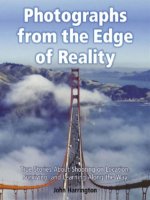photographs from the edge of reality true stories about shooting on location, surviving, and learning along the way
Bạn đang xem bản rút gọn của tài liệu. Xem và tải ngay bản đầy đủ của tài liệu tại đây (21.88 MB, 305 trang )
“John Harrington’s Photographs from the Edge of Reality is a real how-to
book that gives aspiring shooters insight into the real world of assignment
photography. Harrington has done it again when it comes to describing
his innovative approach to his profession and his ability to share it with
the world.”
—David Hume Kennerly, Pulitzer Prize–winning photographer
“When John Harrington goes on assignment, you go with him. It’s more
than just loading your memory cards and batteries. It’s figuring out
where you need to be and how to get there. John is a pro at business,
and with his new book, he shares some of his hard-won secrets for how
to make your clients as happy with your pictures as you are.”
—David Burnett, award-winning photojournalist
and co-founder of Contact Press Images
“Great stories from a great guy. Read this book.”
—Bill Frakes, award-winning photographer
“John shows you the world of Washington, DC photography behind
the pomp and power posturing. If you want to learn how to do it right,
then this is the book for you.”
—Cameron Davidson, award-winning photographer
“With this book, John does not attempt to glorify or sugar-coat what it
is REALLY like to be a news photographer. This leads to a much more
introspective and interesting look into the behind-the-scenes world
that most will never get to experience. I can see this book appealing to
both photographers as well as everyday people who are interested in
the details of what happens BEHIND the camera—not just in front of it.”
—Vincent Laforet, Pulitzer Prize winner and former
New York Times photographer
This page intentionally left blank
Photographs
from the Edge
of Reality:
True Stories About
Shooting on Location,
Surviving, and Learning
Along the Way
John Harrington
Course Technology PTR
A part of Cengage Learning
Australia, Brazil, Japan, Korea, Mexico, Singapore, Spain, United Kingdom, United States
© 2011 John Harrington.
ALL RIGHTS RESERVED. No part of this work covered
by the copyright herein may be reproduced, transmitted,
stored, or used in any form or by any means graphic,
electronic, or mechanical, including but not limited to
photocopying, recording, scanning, digitizing, taping,
Web distribution, information networks, or information
storage and retrieval systems, except as permitted
under Section 107 or 108 of the 1976 United States
Copyright Act, without the prior written permission of
the publisher.
All trademarks are the property of their respective
owners. All images © John Harrington unless
otherwise noted.
Library of Congress Control Number: 2010936614
ISBN-13: 978-1-4354-5782-9
ISBN-10: 1-4354-5782-X
Course Technology, a part of Cengage Learning
20 Channel Center Street
Boston, MA 02210
USA
Cengage Learning is a leading provider of customized
learning solutions with office locations around the
globe, including Singapore, the United Kingdom,
Australia, Mexico, Brazil, and Japan. Locate your
local office at: international.cengage.com/region.
Cengage Learning products are represented in Canada
by Nelson Education, Ltd.
For your lifelong learning solutions, visit courseptr.com.
Visit our corporate Web site at cengage.com.
Photographs from the Edge
of Reality: True Stories
About Shooting on Location,
Surviving, and Learning
Along the Way
John Harrington
Publisher and General
Manager, Course Technology
PTR: Stacy L. Hiquet
Associate Director of
Marketing: Sarah Panella
Manager of Editorial
Services: Heather Talbot
Marketing Manager:
Jordan Castellani
Acquisitions Editor:
Megan Belanger
Project and Copy Editor:
Cathleen D. Small
Interior Layout:
Shawn Morningstar
Cover Designer:
Mike Tanamachi
Indexer:
Kelly Talbot Editing Services
Proofreader:
Kim V. Benbow
For product information and technology
assistance, contact us at
Cengage Learning Customer and Sales Support,
1-800-354-9706.
For permission to use material from this
text or product, submit all requests online at
cengage.com/permissions.
Further permissions questions can be
e-mailed to
Printed in the United
States of America
1 2 3 4 5 6 7 12 11 10
eISBN-10: 1-4354-5783-8
To Charlotte—
My best friend, my champion,
my partner, my muse.
For my girls—
These are some of the stories I’ll
recount to your children.
Acknowledgments
It is with heartfelt thanks that I express my appreciation and
gratitude to the professionals, friends, and family who have had
an influence on my life and development over the years. To my
siblings—Laura Rettinger, Robert Harrington, and Suzanne Seymour,
and my extended Harrington/Seymour/Taylor siblings—thank
you for allowing me to grow up with and through you.
To Charlotte Richardson: Thank you for your efforts in helping
me to clarify these stories and for your recollections of projects
we worked on together that helped remind me of just how dif-
ficult many of these assignments were. Thank you for always
being there for me during the many years we’ve been friends.
To my editors: Project editor Cathleen Small, and acquisitions
editor Megan Belanger, thank you for shaping and helping to
make sense of the stories and getting them organized in a logical
way, and to Shawn Morningstar, for her gentle guidance on how
to best present the text and visuals.
To my office staff on hand for this book—Talley Lach, Suzanne
Behsudi, and Lindsay King—thank you for your hard work and
efforts amidst the many personal and professional distractions
during the production of this book.
To Ken Weber, who published my first photo essay, which led to
my working for my first editor, David Hill, at The World & I mag-
azine. Thank you both.
To photographer Nick Crettier, who is a mentor and friend, both
professionally and personally. To photographers Michael Spilotro
and Ken Cedeno, both of whom have challenged everything I
know about photography, sometimes just trying to prove me
wrong, but always trying to be helpful. And to Mark Finkenstaedt,
Bill Auth, Paul Morse, David Hobby, David Burnett, Cameron
Davidson, Jessica D’Amico, Jamie Rose, Jeff Snyder, Karen
Ballard, David Hume Kennerly, Bob McNeely, Vincent Laforet,
Ralph Alswang, Cliff Owen, Bill Frakes, and Bill Foster for your
friendship and professional guidance over the years.
v i
About the Author
John Harrington arrived in the nation’s capital in 1985 as a
student and began his formal freelance career in 1989, before
graduating from college. He built a successful photography
business and has spoken at numerous courses, seminars, and
meetings on the subjects of business practices for photographers
and his creative vision. Among the organizations he’s made
presentations before are the American Society of Media
Photographers, Advertising Photographers of America, National
Press Photographers Association, the White House News
Photographers Association, PhotoPlus Expo, the Smithsonian
Institution, Corcoran School of Art and Design, and the University
of Maryland. In 2007 John was awarded the International
Photographic Council’s Leadership Award at the United Nations.
He has worked for more than 20 years as an active photogra-
pher in Washington, DC and around the world, with both edi-
torial and commercial clients. Editorially, his credits include the
Associated Press, The New York Times, The Washington Post, Time,
Newsweek, U.S. News & World Report, the National Geographic
Society, USA Today, People, MTV, and Life, among hundreds of
others. Commercially, John has worked with more than half of
the top Fortune 50 companies and even more of the top Fortune
500. John has worked on ad campaigns for Siemens, Coca-Cola,
General Motors, Bank of America, and XM Satellite Radio, to
name a few, which have been seen worldwide.
In addition to this book, John has authored Best Business Practices
for Photographers, now in its second edition, and his photography
has illustrated four books, three specially commissioned by the
Smithsonian Institution’s National Museum of the American
Indian: Meet Naiche (2002), Meet Mindy (2003), Meet Lydia (2004),
and Patriotism, Perseverance, Posterity: The Story of the National
Japanese American Memorial (2001).
v i i
John is currently serving his second term as the president of the
White House News Photographers Association and has served on
the boards of the local chapters of the Art Directors of Metropolitan
Washington, the American Society of Media Photographers, and
the American Society of Picture Professionals.
Photographs from the Edge of Reality
v i i i
Introduction . . . . . . . . . . . . . . . . . . . . . . . . . . . . . . . . . . . . . xi
Ascending to an Historic Summit: Bush and Gorbachev . . . 1
Pool Spray in the Oval . . . . . . . . . . . . . . . . . . . . . . . . . . . . . 9
Lean Green Entertaining Machine . . . . . . . . . . . . . . . . . . . 15
Harrier Jet Liftoff: No Time for Indecision . . . . . . . . . . . . . 21
Don’t Let the Fear of Striking Out Get in Your Way . . . . . 27
Ice Cream Social with Obama. . . . . . . . . . . . . . . . . . . . . . . 33
Donny Osmond, Snoop Dogg, Weird Al,
and Coolio…Oh My! . . . . . . . . . . . . . . . . . . . . . . . . . . . 39
Three Locations, 45 Minutes…No Problem!. . . . . . . . . . . . 45
Rolling Stones: Shooting the Voodoo Lounge Kickoff . . . . . . 51
An Excursion to Cuba. . . . . . . . . . . . . . . . . . . . . . . . . . . . . 57
National Geographic and the White House . . . . . . . . . . . . 71
The Blizzard of 2010 . . . . . . . . . . . . . . . . . . . . . . . . . . . . . . 81
It’s All About the Drinks. . . . . . . . . . . . . . . . . . . . . . . . . . . 89
From New Orleans to Crawford for a Pool Date
with the President . . . . . . . . . . . . . . . . . . . . . . . . . . . . . 93
January 20th: A Truly Washington Moment . . . . . . . . . . . 99
Obama’s Inaugural Walk . . . . . . . . . . . . . . . . . . . . . . . . . 107
Smithsonian Books . . . . . . . . . . . . . . . . . . . . . . . . . . . . . . 115
In the Studio with Sam Abell . . . . . . . . . . . . . . . . . . . . . . 131
Aretha Lets Loose . . . . . . . . . . . . . . . . . . . . . . . . . . . . . . . 137
i x
Table of Contents
Atop the Golden Gate Bridge . . . . . . . . . . . . . . . . . . . . . . 145
John Lewis: Three Minutes or Less . . . . . . . . . . . . . . . . . 153
Pomp and Circumstance at the White House. . . . . . . . . . 159
Air to Air over a Frigid Washington . . . . . . . . . . . . . . . . . 165
Europe on a Shoestring . . . . . . . . . . . . . . . . . . . . . . . . . . 175
Live 8: Hallelujah! The Reverend Al Sharpton
Delivers Destiny . . . . . . . . . . . . . . . . . . . . . . . . . . . . . . 185
Fireworks at Iwo Jima . . . . . . . . . . . . . . . . . . . . . . . . . . . 189
The Captain’s Jersey Retirement . . . . . . . . . . . . . . . . . . . 193
Danica Patrick and the 20¥40 Softbox . . . . . . . . . . . . . . . 197
Clarence Thomas and Anita Hill: Head to Head . . . . . . . . 201
Plant–The Pure Professional . . . . . . . . . . . . . . . . . . . . . . . 205
Vanity Press Corps. . . . . . . . . . . . . . . . . . . . . . . . . . . . . . . 209
September 11, 2001 . . . . . . . . . . . . . . . . . . . . . . . . . . . . . 215
Seal Wins Approval from Ambassadors to Bullfighters . . 225
Nelson Mandela: Dignity with Disability . . . . . . . . . . . . . 231
Keeping Cool in New Orleans . . . . . . . . . . . . . . . . . . . . . 237
The 9/11 United We Stand Concert . . . . . . . . . . . . . . . . . . 243
Ten Seconds with the President . . . . . . . . . . . . . . . . . . . . 253
Kristin Davis: Dogs and the City. . . . . . . . . . . . . . . . . . . . 257
A Presidential Debate and an Exercise in Diplomacy. . . . 261
Stevie Wonder: Portrait Composite. . . . . . . . . . . . . . . . . . 269
Arlington Cemetery: Grieving Mothers . . . . . . . . . . . . . . 275
Index . . . . . . . . . . . . . . . . . . . . . . . . . . . . . . . . . . . . . . . . . 281
Photographs from the Edge of Reality
x
Introduction
As I traveled around the world as a photographer, it quickly
became apparent that stories such as, “I was stuck on an
overnight train, sleep deprived, en route to Warsaw, Poland, as
border guards were demanding my travel documents at 4 a.m.
in a language I didn’t understand…,” or, “I found myself cele-
brating the Fourth of July with the Mexican ambassador, being
serenaded by Ben Vereen…,” or, “The president looked right
at me as he was walking down Pennsylvania Avenue…”
all seemed surreal to friends, family, and even colleagues. They
seemed, in fact, made up or unreal. Fortunately, my reason for
being there is to document (with a camera) these circumstances
seemingly from the edge of reality—hence the title of this book.
Very early in my career, I began writing dispatches and sending
them off to family, usually by email, well before the age of the
Internet as it is today. It saved me time, as I didn’t have to recount
the stories repeatedly and chance leaving something out.
Yet, over time, my life got a bit crowded, and I lost the time to do
these dispatches as I used to. However, as most photographers
will tell you, their photographs are not just images to them, but
an instant reminder of not just what was seen through the
viewfinder, but also the environment outside of the frame—from
weather, to assignment challenges, to the shot that got away.
I also remember lighting setups, and on film assignments I can
remember f-stops, shutter speeds, and usually focal lengths, too.
It’s a form of instant recollection that I am putting down on
paper here—not just to weave a tale from assignments past, but to
bring these stories back to life and share with you, dear reader,
what went into the assignment. The challenges overcome, the
missed shots, the lighting setups, and even, in some instances,
the full take, so you can see how a moment in time gets captured
and selected
x i
Previously, I wrote the book Best Business Practices for Photographers,
and you’ll find some of that information in this book too; but
if you’re looking for a business guide, that would be the book
to buy. However, if you want to read about actual assignments
and how they were achieved—from photographing presidents,
to working on assignment in Eastern Europe, to capturing the
biggest names in rock-and-roll and Hollywood, often making
something out of nothing—then this is the book for you.
In more than 20 years as a photographer—and, God willing, at
least another 20 or so more—I have had the good fortune to
travel the world on someone else’s dime to make great images.
Here are the stories behind some of them.
Photographs from the Edge of Reality
x i i
En route to Europe on assignment, somewhere over the Atlantic,
working on a dispatch as the sun sets.
1
E
verybody has a story about “how it all began.” This is my
story. It was late spring of 1990, and the Cold War was
thawing rapidly. I was just a few weeks away from grad-
uating college when I learned that the credentialing process was
to begin for the summit between President George H.W. Bush
and Soviet leader Mikhail Gorbachev. By this point I’d had a bit
of success in working with one client—The World & I magazine—
on a freelance basis. So, I approached them about covering the
summit.
Ascending
to an Historic
Summit: Bush
and Gorbachev
Because I had a track record with them, they were amenable to
giving me an assignment, and they wrote a letter requesting a
credential. I was 23 years old at the time and far less schooled in
the ways of the world or even how the press corps worked. Yet,
I wanted to make it work, somehow.
Photographs from the Edge of Reality
2
My very first press credential.
Sitting on the edge of the flower boxes
at the North Portico of the White House
before President Gorbachev arrives for
the state dinner in his honor.
I sent in the letter and the requisite headshot for my credential,
and I waited. A few weeks later, I was told I had a credential and
just one press pass—to the arrival ceremony on the South Lawn
of the White House. Although I thought this was really cool, I
was disappointed because I wanted to be everywhere doing
everything—how little I knew!
The visit began in May, and each event was controlled by a pool
pass. I won’t go into detail on what a pool is, because I’ll do that
in the next chapter. Suffice it to say that being in the pool this
time meant I was a part of a small cadre of photographers given
access, and, in this case, I did not have to share my images with
other photographers, as “poolers” nowadays do.
The first event was the arrival ceremony, and I had a pass for that.
For each event, the press was screened at the press-filing center
at George Washington University, then taken by motorcade to the
event, and then returned to the GWU center. As I was waiting
for the bus to depart for the arrival ceremony, I learned we were
waiting for several people who had not claimed their pool passes
by checking in and who would not be allowed into the event. This
got me to thinking during the downtime before the ceremony….
Ascending to an Historic Summit:
Bush and Gorbachev
3
On the ride back, I (politely) cornered the press handler and
made a proposition. I suggested that it seemed a waste for photo
positions to go unused, and that the more photographers the
more coverage, so why not distribute any unclaimed passes by
way of a waiting list that could be made up in the time leading
up to the next event? The press handler thought about it for a
minute and agreed with me that it was a good idea.
The next event was to be a luncheon at the Russian Embassy, and
I said, “Can I be on the waiting list for the embassy luncheon?”
I was told yes, so I rushed off the bus, re-cleared security, and
waited at the front of the line. When the call time came for the
embassy, I made it in because I was on the waiting list, and
someone didn’t show.
Coming back from the embassy, I positioned myself to be off the
bus first so I could repeat this again. I ended up going to Camp
David, getting into the Oval Office, and covering the signing cer-
emony in the East Room of the White House. In the end, I had
more than a dozen passes through this system I had invented
and somehow gotten approval for. I was, of course, missing all
manner of classes near the end of the semester, but I didn’t care.
Photographs from the Edge of Reality
4
Secret Service on duty around President Gorbachev’s limousine.
Ascending to an Historic Summit:
Bush and Gorbachev
5
President Bush and
President Gorbachev
disembark Marine One
at Camp David.
The Gorbachevs and the Bushes get arranged properly for a press photo op at Camp David.
Photographs from the Edge of Reality
6
The Gorbachevs and the Bushes pose for a press photo op at Camp David.
After the summit was over, I turned up at the magazine with all
my credentials proudly displayed around my neck. I wanted to
impress the photo editor, and it must have worked. I handed
him all my film to process, and he asked how I had gotten into
so many events, so I explained my little system. He processed my
film, and within about a week he told me I had so many images
that they didn’t need to get them from the news agencies.
Instead, they could get them solely from me, and the entire two-
page spread about the summit would be just my images.
Ascending to an Historic Summit:
Bush and Gorbachev
7
After I graduated in September of that year, the staff photogra-
pher for the magazine told me that he was going to move to
another job, and if I wanted the staff photography job at the
magazine, he would recommend me for it. I was honored and
humbled. His boss, the photo editor, agreed with the recom-
mendation, since I had proven my abilities already. Yet, when I
met with the publisher of the magazine, my portfolio consisted
only of images his magazine had published.
“Don’t you have anything else to show me?” came the inquiry.
“No sir, just images that your magazine has published. And I
have enjoyed all the assignments to date and would love to work
here full time.” And with that and no formal training in photog-
raphy, my first job out of college was as staff photographer for
The World & I magazine. I immediately applied for credentials
to cover Capitol Hill, and I was told when I got “card access”
credentials to the White House that I was the youngest photo-
grapher to be covering the White House on a regular basis.
Whether or not this was true, it surely was an eye-opening
experience from day one, and I learned that where there’s a will,
there’s a way—and sometimes you have to make your own way.
Photographs from the Edge of Reality
8
9
W
hen you’re a member of the press corps, taking pho-
tographs in the Oval Office of the White House is
usually a brief experience. Over the years, the time
allotment has gotten shorter and shorter. Nowadays, it’s usually
about 20 seconds. I’ve had the privilege of being in there as a
guest of the president, sans camera, as well as accompanying
delegations during a private meeting with a president. Although
when I’ve not been under such time constraints I’ve had far more
of an opportunity to, as the saying goes, “make art,” choosing my
angles and moments to capture, my normal experience lasts well
under a minute.
When you’re standing outside “the Oval” on the colonnade look-
ing over the Rose Garden, a number of things are going through
your mind—who’s in front of you, how many people are in front
of you, where you’ll position yourself during the precious few
seconds you’ll have, what lens you’ll want to utilize, and so on. It
used to be that you needed to consider whether you were using
a strobe, but with digital at high ISOs being the norm, jettisoning
the strobe means you don’t have to wait for flash recycles, and
you can squeeze off a few more frames.
Pool Spray in
the Oval
Photographs from the Edge of Reality
10
Waiting in the colonnade to go into the Oval.
A quick snap of me in the window, waiting to get into the Oval, with the Rose Garden in the background.
There are many strategies to going in: If you’re last in the line,
you likely won’t get a head-on shot, so perhaps you go for the
side shot and then a frame showing the many members of the
press there, with an ultra-wide lens. You can also linger for a
couple seconds as the rest of the photographers are getting up
and make a few frames that might look less scripted than those
your colleagues made a few minutes ago. Most times, the wire-
service photographers (the Associated Press, Reuters, and Agence
France Presse) are at the front of the line, so they’re going for
the head-on, low-angle shot. Although that is a staple of news-
papers around the country, knowing what they are getting allows
you to get into a different position and make a slightly different
image.
There are essentially two settings in the Oval for photography.
The first is of two world leaders seated side by side in front of the
fireplace. The second—and less common—setting is of the pres-
ident at his desk, usually signing a bill with congressional leaders
looking on.
Earlier this day, we had traveled by motorcade to a nearby hotel
as the president gave remarks to the Grocery Manufacturers
Association and also named the new Secretary of Agriculture—
Ed Schafer—to a cabinet post. Now, late in the afternoon on a
busy news day, the president was signing a bill in the Oval, and
the press was called in to document the event. In this case,
President George W. Bush was signing the Internet Tax Freedom
Act Amendments Act of 2007—a bill to amend the Internet Tax
Freedom Act, which extends the moratorium on taxes for pur-
chases made on the Internet. This seems like a mouthful—what
it does is save you from paying taxes on purchases you make on
the Internet when the sale is taking place outside of your state.
The president was joined by several members of Congress, among
them Rep. Goodlatte of Virginia, Sen. Sununu of New Hampshire,
and Sen. Alexander of Tennessee. I made a few of the obligatory
front-on images within the first few seconds and then quickly
shifted to my left to do a side shot of the press pool in action.
Pool Spray in the Oval
11
Now would be a good time to explain what a “press pool” is. In
press circles in Washington, a pool is essentially an abridging of
the First Amendment rights of the press. Consider, for example,
that you have 50 news outlets that want to cover a news event.
Clearly, you could not fit all of them into the Oval. So, the White
House (and other news-centric bodies around the city) essen-
tially says, “Well, guys, we can’t fit 50 of you into the space we
have, so either no one can come in or five of you come in and
each of you five agree to share your images among 10 others.”
Thus, in concept, each group of 10 has to “pool” its needs and
resources into the hands of one (hopefully) able-bodied photo-
grapher.
At the White House, the wires (AP, Reuters, AFP) have stead-
fastly refused to pool images (much to their credit), and the news
magazines (Time, Newsweek, and US News) all have agreed to a
“mag pooler.” Sometimes the newspapers (Washington Post, The
New York Times, and so on) have agreed to a “newspaper pooler.”
Photographs from the Edge of Reality
12
A side shot of the signing ceremony to show the press documenting the event.









